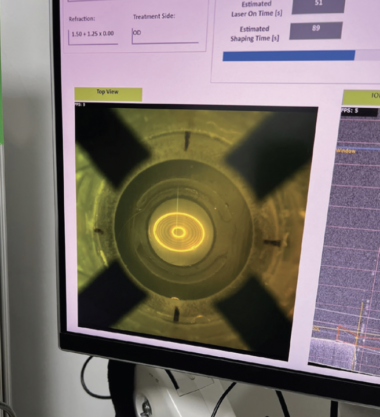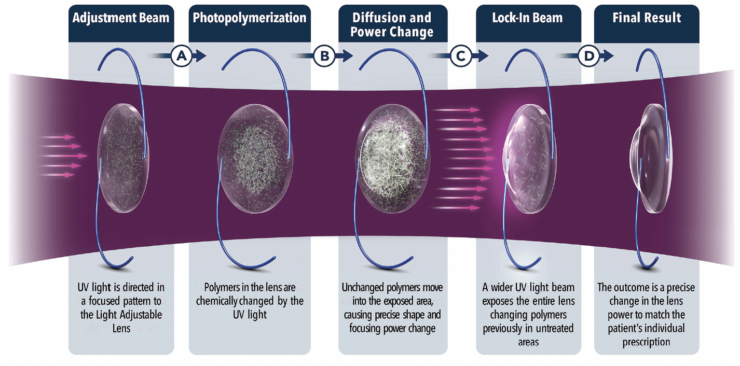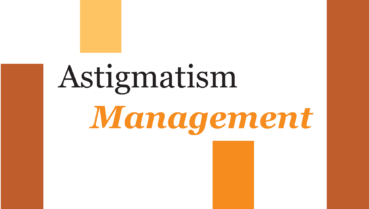
This article describes three technologies that allow different types of noninvasive correction, including cylindrical and spherocylindrical, after cataract surgery.
REFRACTIVE INDEX SHAPING
How it works. Perfect Lens developed refractive index shaping (RIS) technology for the noninvasive adjustment of IOL power with a femtosecond laser. The laser uses green light and operates at a much lower energy level than is required for ablation or cutting. The technology may be used with acrylic IOLs already on the market.1,2
The application of laser energy induces a chemical reaction in a specific area within the substance of the IOL, simultaneously causing an increase in hydrophilicity and a decrease in the refractive index. At the molecular level, hydrolysis occurs when the IOL polymeric material is exposed to laser energy and hydrophilic functional groups form. Because the lens is in an aqueous medium, hydrogen bonds form between water molecules and the new functional groups while the integrity of the polymeric material is preserved. A phase-wrapping algorithm is used to shape an ultrathin, high-diopter lens layer within the existing IOL. Several other corrections may be made later using areas above or below the initial area.
Laser treatment is fast, and the patient requires only topical anesthesia. The IOL changes do not occur immediately, because they require complete hydration of the treated area within the lens. This is reached at different time points, depending on the base material of the IOL. Astigmatic treatment may be performed after the IOL has stabilized inside the capsular bag. Even high levels of customized toricity can be achieved (Figure 1).

Research results. My colleagues and I evaluated the IOL power, modulation transfer function, light transmission, and light scattering of a blue light–filtering IOL before and after power adjustment with a femtosecond laser.3 Ten one-piece yellow hydrophobic acrylic IOLs were used in the study. All measurements were performed on hydrated IOLs. The lenses were also evaluated with light microscopy before and after laser adjustment. A mean power change of -2.037 D was associated with a modulation transfer function change of -0.064 and a light transmittance change of -1.4%. Back light scattering increased within the IOL optic in the zone corresponding to the laser treatment at levels that were not expected to be clinically significant. Treated areas within the optic could be well appreciated with light microscopy without damage to the IOLs.
We also evaluated the uveal and capsular biocompatibility of IOL power adjustment with a femtosecond laser in vivo in a rabbit model.4 Six rabbits underwent phacoemulsification and bilateral implantation of a commercially available hydrophobic acrylic IOL. The postoperative power adjustment was performed 2 weeks after IOL implantation in one eye of each rabbit. The animals were observed clinically for 2 weeks and then euthanized. Slit-lamp examinations performed after laser treatment found that small gas bubbles formed behind the lenses and disappeared within a few hours. No postoperative inflammation or toxicity was observed in the laser-treated eyes, and postoperative outcomes and histopathologic examination results were similar to those in untreated eyes. The power measurements showed that the changes in power obtained were consistent and within ±0.10 D of the target. Similar findings were observed in a long-term rabbit study (follow-up period of 6 months after laser treatment; unpublished data).
The first human clinical trial of the RIS technology started in Panama but was interrupted by the COVID-19 pandemic. It resumed in 2022. All patients enrolled to date received monofocal one-piece hydrophobic acrylic lenses (Tecnis Monofocal 1-Piece, Johnson & Johnson Vision). Postoperative laser treatments, usually lasting approximately 89 seconds, were performed for spherical, cylindrical, and spherocylindrical corrections. No postoperative drops were administered after laser treatment, only artificial tears.
Data are available for seven patients treated in 2022 and show that the desired refraction change was close to the actual refractive change obtained when no movement was observed during treatment. Changes to the flexible silicone interface were made to constrain involuntary eye movement during RIS. There was no loss of contrast sensitivity or change in color perception. A patient questionnaire on visual disturbances found no complaints of halos or glare after laser treatment (unpublished data).
Additional application. RIS technology could be used in IOL manufacturing. Full customization of monofocal IOLs with RIS could be performed at the manufacturing facility, and the lenses could be shipped before surgery. Potential advantages include a low cost for premium optical features, fewer safety limitations (because the lens would not be inside the eye at the time of laser treatment), and lower inventory costs. Manufacturers, moreover, would use their own proprietary materials without having to alter their manufacturing processes for different types of lenses.
LASER-INDUCED REFRACTIVE INDEX CHANGE
How it works. Clerio Vision developed laser-induced refractive index change (LIRIC) technology. Treatment with a 405-nm wavelength femtosecond laser system induces refractive index changes. In principle, LIRIC and RIS are similar.5-8 To date, LIRIC technology has been tested on the cornea, contact lenses, and IOLs. Most studies have focused on its use in the cornea. After cataract surgery, LIRIC treatment can inscribe a variety of optical patterns within the cornea or the IOL to correct residual refractive errors, including astigmatism.
The laser operates at a pulse energy that is 100 to 1,000 times lower than the flap-cutting regimen currently used in femtosecond LASIK. No tissue is ablated during LIRIC. The refractive index is changed through modification of the mixture of collagen and water within the treated micrometer-sized region of the corneal stroma. Specifically, the application of laser energy modifies the collagen matrix so that the collagen fibrils are more densely packed.
Avoiding tissue ablation obviates concern about corneal ectasia. LIRIC preserves the original corneal curvature and avoids epithelial remodeling and the subsequent regression seen in the early days of laser refractive surgery. The low pulse energies, moreover, have been shown histologically to preserve the stromal nerves, which could reduce the incidence of postoperative dry eye. All of this provides the potential to repeat treatment on the same eye without significantly changing the cornea.
The corneal procedure takes just under 90 seconds. The goal is to reduce treatment time to less than 20 seconds.
Research results. In vivo animal experiments found that the effect of LIRIC treatment persisted in the cornea for up to 2 years. No detrimental effect on corneal endothelial cells was observed.7,8
In the first clinical study (n = 27 patients) conducted to establish safety outcomes,5 no eyes exhibited inflammation or a wound-healing response. All corneas were clear after treatment. There were no signs of haze, scarring, endothelial damage, or opacity. A flat-applanation patient interface similar to flat applanation for cutting a LASIK flap was used. Patients recovered in approximately 24 hours and did not need routine topical antibiotics or steroids for the first 5 to 7 days following treatment.
LIRIC contact lens research is currently focused on presbyopia correction (eg, embedding diffractive bifocal or trifocal patterns in the contact lens; Figure 2) and myopia control. The use of other wavelengths, such as 520 nm (green) and 1,035 nm (near infrared), is also being explored.

Figure 2. A diffractive multifocal pattern is written inside a contact lens with LIRIC.
Courtesy of Len Zheleznyak, Clerio Vision
LIGHT ADJUSTABLE LENS
How it works. The Light Adjustable Lens (LAL; RxSight) is a three-piece silicone lens with modified-C PMMA haptics, a 6-mm optic, and an overall length of 13 mm. The medical-grade UV light–filtering silicone optic contains a light-activated photoinitiator and mobile silicone macromers. The application of UV light (365 nm) causes these macromers to polymerize in the treated area. Subsequent diffusion of unpolymerized macromers to the treated region changes the LAL’s shape and thus its power (Figure 3).9 Light treatment can adjust the LAL’s spherical power from -2.00 to +2.00 D and its cylindrical power from -0.50 to -2.00 D in 0.25 D increments. Once the desired refractive outcome has been reached, it is locked in with a final light treatment.

Figure 3. The mechanism of power change with the LAL.
Courtesy of Roy Freeman, RxSight
The first light treatment is typically performed 2 to 3 weeks after LAL implantation. Three to five total light treatments, each lasting approximately 90 seconds and separated by approximately 3 days, are usually required. The patient wears proprietary UV-protective glasses until the lock-in treatment is performed. The latest-generation LAL features an ActivShield UV-protective layer in the anterior part of the lens that helps protect against unwanted UV exposure. This may eliminate the possibility of uncontrolled UV polymerization due to patient noncompliance with instructions to wear UV protection, but clinical studies are required.
Clinical experience. According to RxSight, more than 700 surgeons implant the LAL regularly. For a firsthand account of one surgeon’s clinical experience, see Benefits of a Light Adjustable Lens for Astigmatic Eyes.
CONCLUSION
The FDA approved the LAL in 2017, but RIS and LIRIC technologies are currently under investigation. It remains to be seen if and how the application of these technologies changes astigmatism management in the future.
1. Bille JF, Engelhardt J, Volpp HR, et al. Chemical basis for alteration of an intraocular lens using a femtosecond laser. Biomed Opt Express. 2017;8(3):1390-1404.
2. Sahler R, Bille JF, Enright S, Chhoeung S, Chan K. Creation of a refractive lens within an existing intraocular lens using a femtosecond laser. J Cataract Refract Surg. 2016;42(8):1207-1215.
3. Nguyen J, Werner L, Ludlow J, et al. Intraocular lens power adjustment by a femtosecond laser: in vitro evaluation of power change, modulation transfer function, light transmission, and light scattering in a blue light-filtering lens. J Cataract Refract Surg. 2018;44(2):226-230.
4. Werner L, Ludlow J, Nguyen J, et al. Biocompatibility of intraocular lens power adjustment using a femtosecond laser in a rabbit model. J Cataract Refract Surg. 2017;43(8):1100-1106.
5. Leonard C. LIRIC: A Novel LVC Treatment. Review of Ophthalmology. February 10, 2022. Accessed May 30, 2023. https://www.reviewofophthalmology.com/article/liric-a-novel-lvc-treatment
6. Savage DE, Brooks DR, DeMagistris M, et al. First demonstration of ocular refractive change using blue-IRIS in live cats. Invest Ophthalmol Vis Sci. 2014;55(7):4603-4612.
7. Wozniak KT, Butler SC, He X, Ellis JD, Knox WH, Huxlin KR. Temporal evolution of the biological response to laser-induced refractive index change (LIRIC) in rabbit corneas. Exp Eye Res. 2021;207:108579.
8. Zheleznyak L, Butler SC, Cox IG, et al. First-in-human laser-induced refractive index change (LIRIC) treatment of the cornea. Invest Ophthalmol Vis Sci. 2019;60:9:5079-5079.
9. Ford J, Werner L, Mamalis N. Adjustable intraocular lens power technology. J Cataract Refract Surg. 2014;40(7):1205-1223.


